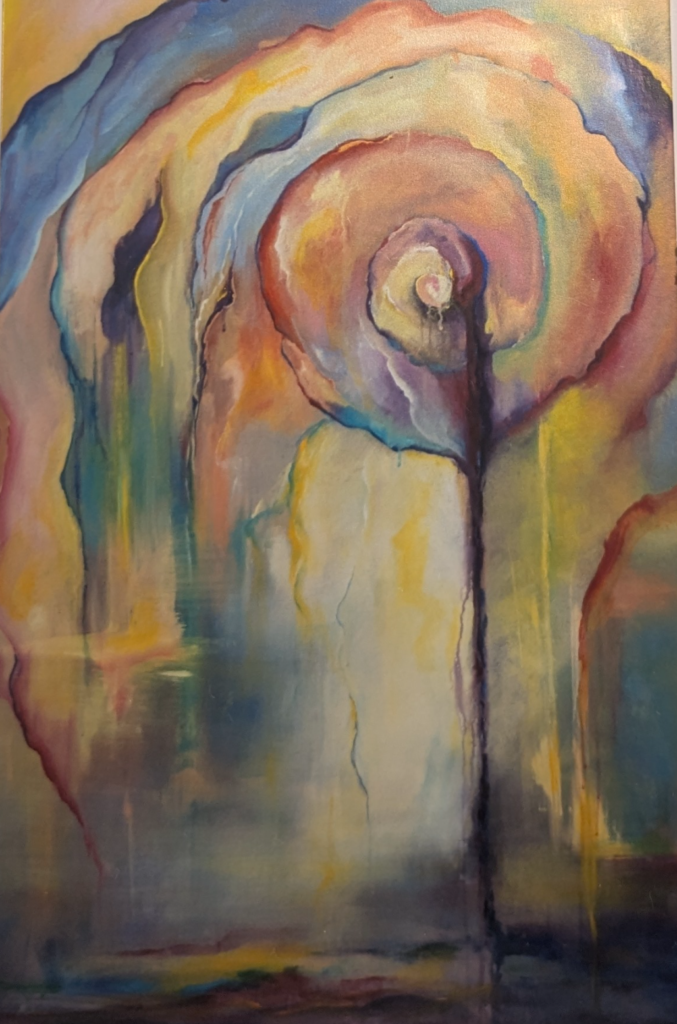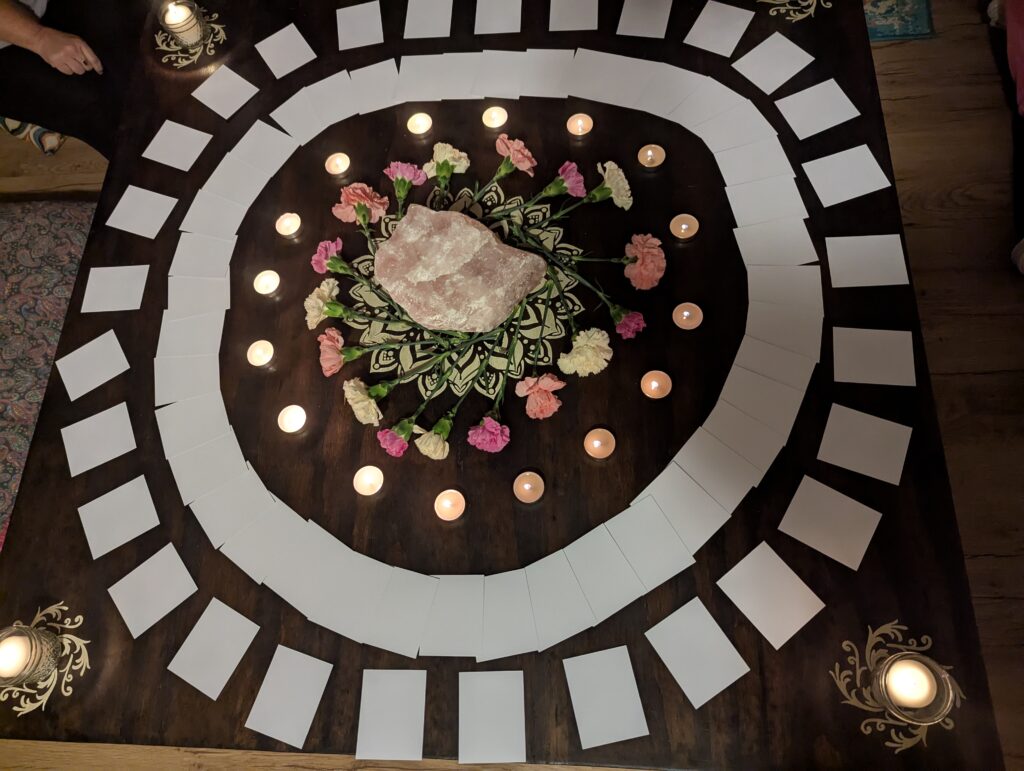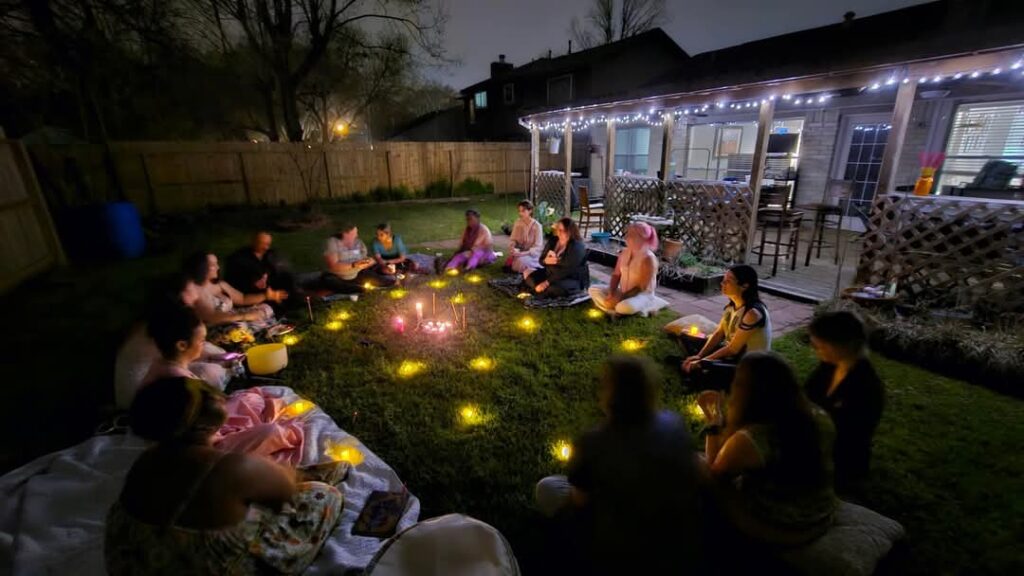I invite you to listen to “Circle of Women” by Nalini Blossoming while reading this, as an inspiration for this story.
This past Saturday, March 8, was International Women’s Day. I found myself at Sawyer Yards with my beautiful friend Leilani, browsing through the open studios and talking to the artists. There was a painting that caught my eye. The artist, Cheryl Russell, explained to me that this piece, “The Gifts of Inanna”, was inspired by the goddess. She told me a bit about Inanna’s story. Inanna was a bit naughty, and wanted to go rule the underworld. On her descent to the underworld, she had to pass through the seven levels of hell. At each level, she had to surrender one of her gifts. When she reached the underworld, she was naked and powerless. In the end, she experienced a death in the underworld, but she was ultimately revived due to the loyalty of her servant Ninshubur, who called on assistance from the other gods (this part Cheryl did not tell me, but I read up on Inanna’s story later). I would have loved to bring home the original painting or even one of the Giclee prints of this piece, but in the end, I settled for a card and the conversation.

Later that weekend, I sat for a while with this card reprint, a candle, and some music inspired by Inanna. I read more about her story, and reflected on how her mythology related to the events of my weekend in its entirety, and what messages her story had to share with us for International Women’s Day. International Women’s Day gives focus to issues such as gender equality, reproductive rights, and violence and abuse against women. This year’s theme, “Accelerate Action”, calls for action that can unlock equal rights, power and opportunities for all and a feminist future where no one is left behind. Inanna’s story of overcoming challenges in the underworld is seen as a powerful symbol of female strength and resilience, making her relevant to contemplate on International Women’s Day.
In addition, her story speaks to the struggle for power and autonomy. Inanna is a goddess who actively pursues power, often challenging male deities and asserting her own authority. One of her most famous myths, Inanna and Enki, tells of how she tricks the god of wisdom into giving her the Me—divine gifts of civilization and power. This reflects the struggles of women who fight for recognition, knowledge, and autonomy in societies that often try to restrict their access to power. Her willing descent into the underworld mirrors the struggles many women experience—whether through personal crises, societal expectations, or systemic oppression—where they must endure loss and transformation to emerge stronger. The surrender of her “gifts” symbolizes how women are often stripped of their power, dignity, or identity to fit societal roles. Eventually, she stands naked and vulnerable before her sister Ereshkigal, much like how women are often judged harshly for their choices, bodies, and ambitions. Inanna’s myth is one of struggle, loss, and resurrection—mirroring the lived experiences of women fighting for their voices, reclaiming their power, and redefining their roles in society. She represents the cyclical nature of women’s challenges and the triumph of resilience, wisdom, and transformation.

Friday night I had started my weekend out with a therapy session, in which I worked through some aspects of my “shadow self’. Soon after this, I drove to Dickinson to join a Soul Sister Circle where we worked through a discussion of our shadow work together. In this experience, the ten women in the group revealed their deepest secrets and vulnerabilities. Inanna’s descent into the underworld illustrates this concept of shadow work, which involves confronting the repressed, hidden, and often painful parts of the self. As Inanna descends, she is forced to remove her crown, jewels, and garments, which symbolize ego, social masks, and false identities. Similarly, shadow work asks us to strip away illusions and confront our authentic selves. When women gather in sacred spaces and engage in shadow work, they re-enact Inanna’s myth—descending into their depths, supporting one another through the journey, and emerging stronger, wiser, and more whole. Inanna dies in the underworld before she is resurrected, symbolizing the death of the old self that often occurs in deep healing work. Shadow work is not just about uncovering darkness but about integrating it, leading to rebirth and empowerment. Inanna teaches that descent is necessary for true transformation and that by embracing both light and shadow, women can reclaim their full power.
Even though our struggles were not all the same, we found we had more in common than we thought, and in each other we found a place of peace, of encouragement and support. Inanna’s revival is only possible because of female solidarity—her loyal servant Ninshubur seeks help from other gods when no one else will. This speaks to the importance of sisterhood and mutual support among women, especially in systems that seek to isolate or disempower them. With the help of our soul sisters to offer collective healing, encouragement, and wisdom, we can find a way to accept those parts of ourselves and integrate them into our journey of transformation.

On Saturday evening, I attended a second women’s circle, this one on the theme of Ostara. In this circle, we took turns sharing on the themes of renewal and new beginnings. Both Inanna and Ostara represent aspects of the divine feminine that facilitate transformation but in a different flavor: Inanna transitions between realms, balancing light and dark, while Ostara transitions between winter and spring, ensuring renewal and balance. Although Ostara and Inanna come from different traditions (Germanic and Sumerian), they share powerful archetypal themes of renewal, fertility, transition, and resurrection. The seasonal cycle of death and rebirth, present in both their mythologies, makes them spiritually connected symbols of transformation.

All of these events were occurring during the current Venus Retrograde, which I found incredibly symbolic. Inanna is closely connected to the goddess Ishtar, and ancient cultures associated both with the planet Venus. The myth of Inanna descending into the underworld mirrors the astronomical phenomenon of Venus appearing to “go backwards” across the sky, symbolizing a period of introspection and confronting one’s shadow self. Inanna shedding her garments at each gate of the underworld represents the need to let go of old patterns and identities during a Venus Retrograde period. During this time, individuals are encouraged to examine their relationships and personal power dynamics, much like Inanna’s journey through the underworld where she must shed her power to access deeper truths.
The myth symbolizes that just like Inanna, Venus retrograde is life’s invitation for us to journey to our own underworld and confront our shadows in love and relationships. It can also be a time where we uncover the truth that’s hidden behind our relationships and reclaim our power. We are shown the people who are true of their intentions, and where we should break our ties with people who do not have the best intentions for us. When Venus ends its retrograde cycle, it is an invitation for us to take the lessons and truths we’ve uncovered from our own underworld journey and reflect on how we can apply them to our lives.
She reminds us of our ability to rise, transform, and reclaim our sovereignty.

One response to “Inanna: Reflections on International Women’s Day”
What a beautiful and inspirational piece of writing! Thank you for including me but truly, I love the way you took my tiny source of inspiration and have now given me so much to think about. You’ve inspired me and I thank you for that. Please come by and visit some time! Perhaps we can meet for tea or coffee. 🙂